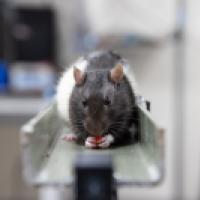Every time we reach for a cup, our brains must assess our hands’ current position in relation to the mug and then command muscles to make the proper adjustments to successfully grab the handle.
The neuroscience of reaching for something and making on-the-spot adjustments has been studied for a century in monkeys.
But now, for the first time, Cornell researchers have developed a technique for studying such motor control in mice – by focusing on a mouse’s tongue when it licks a water spout.
The technique incorporates high-speed cameras and machine learning in a tractable experimental setup that opens the door for revealing mysteries of how the motor cortex works, understanding the neural basis of related disorders like Parkinson’s disease, and informing robotics.
“We now have an approach in a mouse where we can bring all the tools of modern neuroscience to bear on this really classic problem of motor control,” said Jesse Goldberg, associate professor and Robert R. Capranica Fellow in the Department of Neurobiology and Behavior in the College of Arts and Sciences (A&S).
Goldberg is senior author of the paper, “Cortex-dependent corrections as the tongue reaches for, and misses, targets,” published May 19 in Nature. Tejapratap Bollu, Ph.D. ’20, a former graduate student in Goldberg’s lab and currently a postdoctoral researcher at the Salk Institute, and Brendan Ito, a graduate student in the Department of Neurobiology and Behavior, are the paper’s co-first authors.
The field of motor control neuroscience has made advancements almost entirely through studies of monkeys reaching for things, Goldberg said. His lab tried for years to develop a mouse model for much faster and more malleable experiments, but found too many constraints in getting mice to reach with their limbs; mice lack the necessary biomechanics and nature for such movements.
Bollu, who was working on a different project that involved mice licking a water spout, made a discovery that led to the new technique. The water spouts were fitted with contact sensors, but often, the tongue would miss the target.
Bollu “noticed with his careful eyes that [the mice] were actually sticking their tongues out and looking” for the spout, rather than licking as had been assumed, Goldberg said. The movement in mice, which occurs on time scales of close to 100 milliseconds per lick, is analogous to a monkey reaching and making adjustments with its hand, and activates the motor cortex in a surprisingly similar manner, the researchers found.
During a casual conversation between Bollu and co-author Sam Whitehead, a graduate student in the lab of Itai Cohen, professor of physics in A&S, Whitehead suggested they use high-speed cameras to better observe the movements of the mouse tongues. Then, undergraduate co-author James Redd ‘18 helped devise an artificial neural network to sift through terabytes of data from millions of image frames to isolate and track the tongue.
With their system in place, the researchers could observe the tongue reaching for the water spout, just as a human reaches for an object. They could also move the water spout, which forced a miss and an immediate correction. At the same time, genetically engineered mice allowed the researchers to use light to turn different parts of the brain on and off while the animals were drinking.
They inactivated the part of the brain, the anterolateral motor cortex, known to be important for online corrections when a primate reaches.
“We observed that the mice could still lick when they could not make these online corrections, but they missed the spout,” Goldberg said. “That part of the brain was not required to generate a lick, but it was required to contact the spout.”
The researchers were able to use brain activation experiments to zoom in on the anterolateral motor cortex. “The electrical signals there exhibited remarkable similarity to the types of electrical signals people observed in primate reach tasks,” Goldberg said.
“Now we can do experiments that have never been done before,” he said.
Cornell Neurotech has developed technologies that make it possible to record thousands of neurons in an animal at once, for example. In next steps, Goldberg plans to use these tools to characterize for the first time the origins of pathogenic brain signals in neurological disorders, such as Parkinson’s disease.
The study was funded by the National Institutes of Health, the Dystonia Medical Research Foundation, the Pew Charitable Trust, Jean Sheng '77, Kent Sheng '78, the Klingenstein Neuroscience Foundation and the National Science Foundation.






